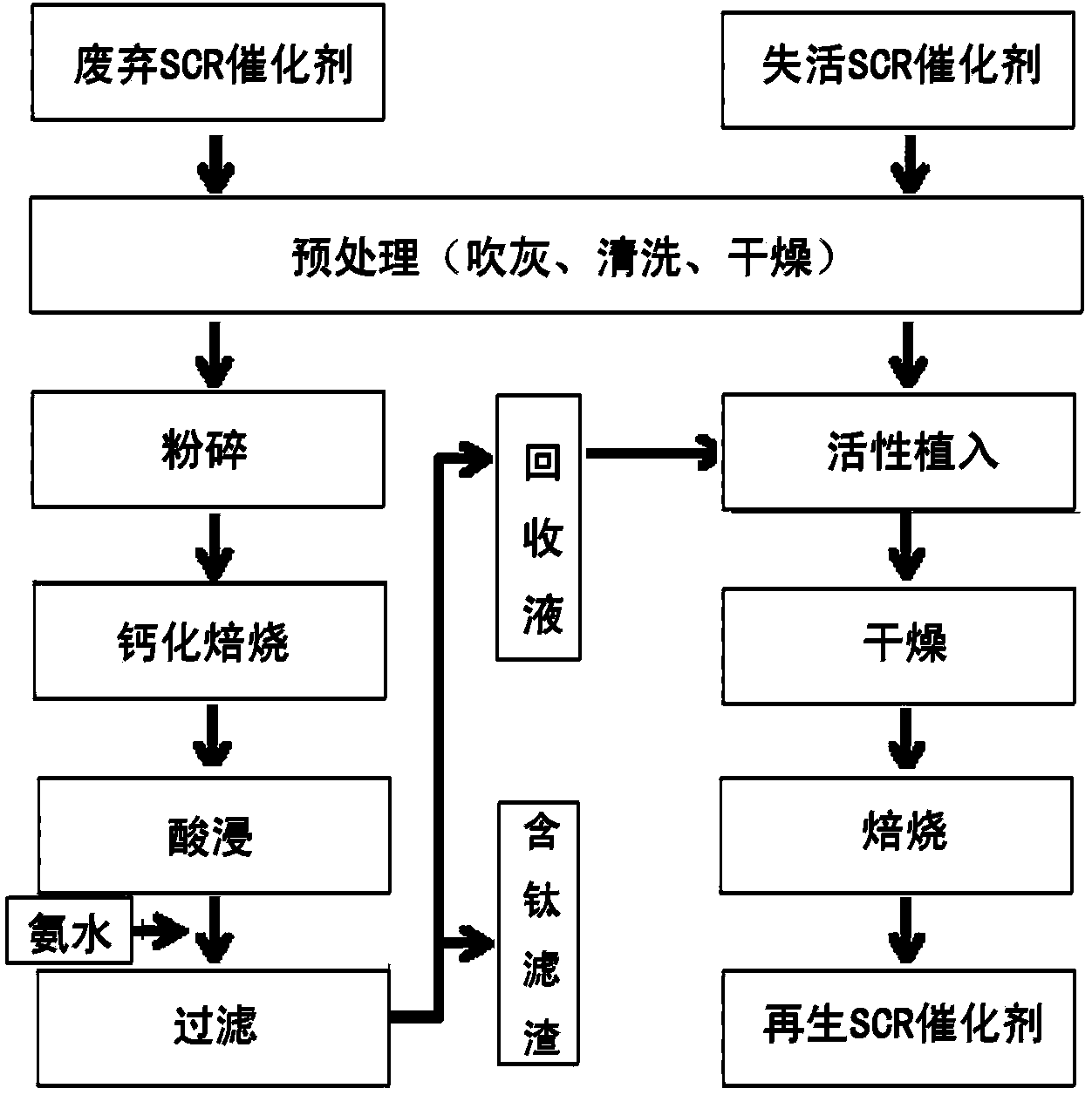Method for regenerating denitration catalyst by utilizing waste SCR (Selective Catalytic Reduction) catalyst recovery liquid
The technology of SCR catalyst and denitration catalyst is applied in the field of regenerating denitration catalyst by using waste SCR catalyst recovery liquid, which can solve the problems of increasing the cost of regeneration process and polluting the environment by harmful metal compounds, so as to save the cost of recovery process, shorten the process cycle and save heavy metals The effect of resources
- Summary
- Abstract
- Description
- Claims
- Application Information
AI Technical Summary
Problems solved by technology
Method used
Image
Examples
Embodiment 1
[0033]Take a waste honeycomb SCR catalyst (size: 68 cm×15 cm×15 cm; service life: 38 months; the intake end is severely worn; the middle part is cracked; the pore clogging rate is about 1 / 6), and use a compressed air gun Purge the fly ash on the surface and in the pores for about 20 minutes, the air pressure is 0.3 MPa, and then use a high-pressure water gun to flush the catalyst pores from the inlet end, and adjust the water pressure to 1 MPa until all the pores are dredged and the surface fly ash is removed. The ashes were washed away, and then the catalyst was put into a blast drying oven, and the temperature was raised to 100°C at a rate of 10°C / min, and kept for 2 h. Take out the catalyst, cut out about 500 g of the catalyst block from the middle, crush it slightly with tweezers, put it into a rotary pulverizer, and after pulverizing for about 3 minutes, add 100 g of calcium carbonate, then turn on the pulverizer for about 3 minutes, and then stop the pulverizer , take ou...
Embodiment 2
[0038] From one end of the catalyst after soot blowing and drying in Example 1, intercept about 500 g of the catalyst block, after slightly crushing with tweezers, put it into a rotary pulverizer, after pulverizing for about 3 min, add 200 g of calcium carbonate, and then pulverize for 3 min , then stop the pulverizer and take out the powder.
[0039] Put the mixed powder into an alumina crucible, then put it into a muffle furnace, raise the temperature to 800 °C at a rate of 4 °C / min, keep it warm for 5 h, and then put the roasted block back into the rotary pulverizer, Crush for about 3 minutes, take out the powder, put it into a beaker, add 1 L of 5% sulfuric acid solution, stir with an electric stirrer for 2 hours in a water bath at 85°C, then adjust the pH value to 10 with ammonia water, add 7 g of MgCl 2 powder and stirred for 30 min, then filtered using vacuum filtration equipment, rinsed the filter residue 3 times with deionized water, collected the filter residue f...
Embodiment 3
[0042] From one end of the catalyst after soot blowing and drying in Example 1, intercept about 500 g of the catalyst block, after slightly crushing with tweezers, put it into a rotary pulverizer, after pulverizing for about 3 min, add 100 g of calcium carbonate, and then pulverize for 3 min , then stop the pulverizer and take out the powder.
[0043] Put the mixed powder into an alumina crucible, then put it into a muffle furnace, raise the temperature to 900°C at a rate of 4°C / min, keep it warm for 3 hours, and then put the roasted block back into the rotary pulverizer, Crush for about 3 minutes, take out the powder, put it into a beaker, add 1 L of 2% sulfuric acid solution, stir with an electric stirrer for 2 hours in a water bath at 90°C, then adjust the pH value to 11 with ammonia water, add 10 g of MgCl 2 powder and stirred for 30 min, then filtered using vacuum filtration equipment, rinsed the filter residue 3 times with deionized water, collected the filter residu...
PUM
 Login to View More
Login to View More Abstract
Description
Claims
Application Information
 Login to View More
Login to View More - R&D
- Intellectual Property
- Life Sciences
- Materials
- Tech Scout
- Unparalleled Data Quality
- Higher Quality Content
- 60% Fewer Hallucinations
Browse by: Latest US Patents, China's latest patents, Technical Efficacy Thesaurus, Application Domain, Technology Topic, Popular Technical Reports.
© 2025 PatSnap. All rights reserved.Legal|Privacy policy|Modern Slavery Act Transparency Statement|Sitemap|About US| Contact US: help@patsnap.com


